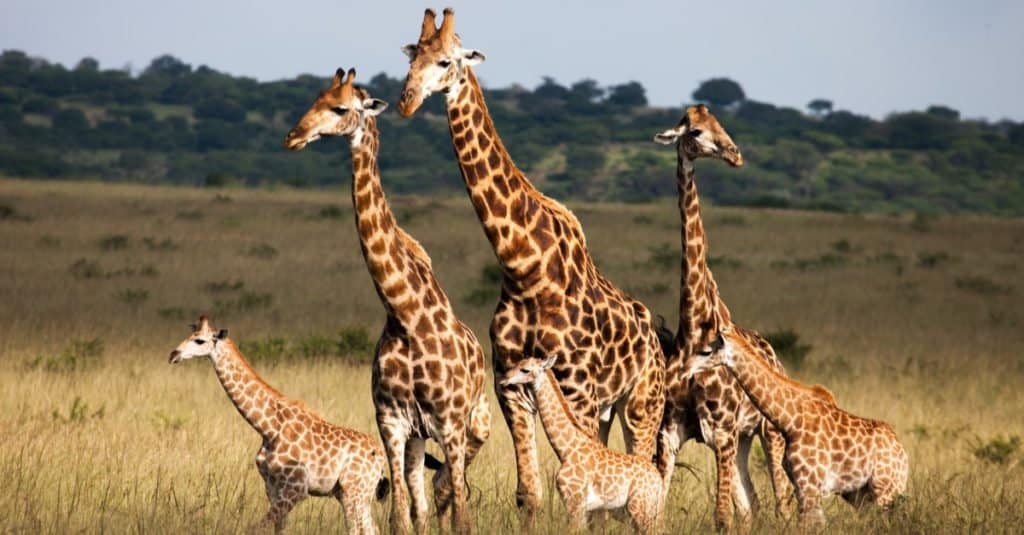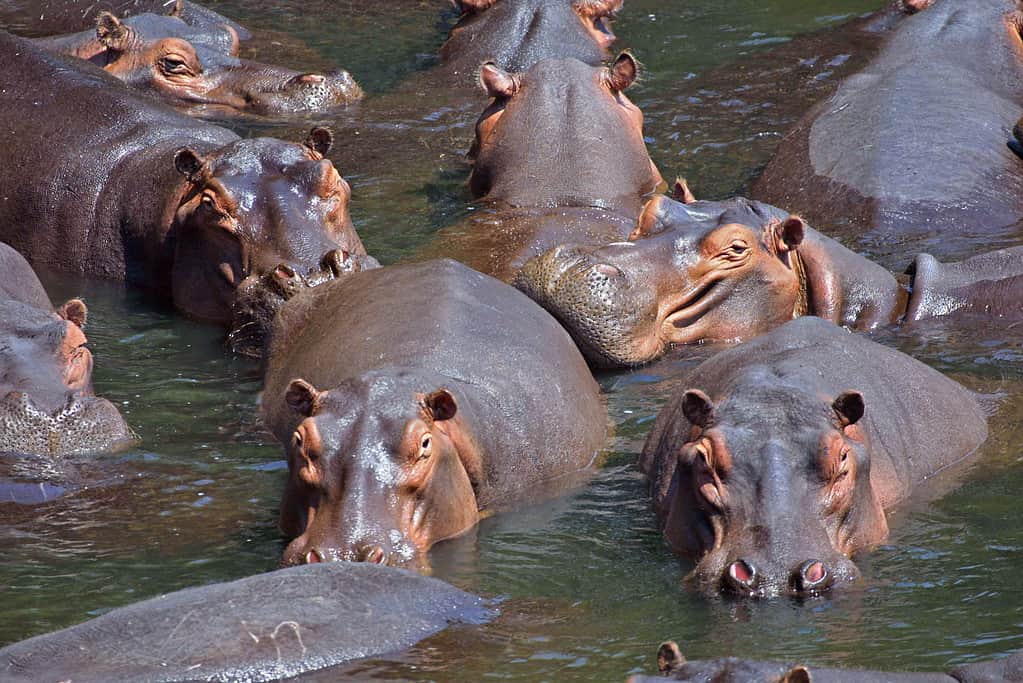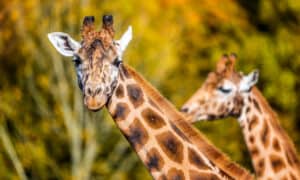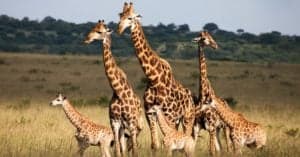Giraffes really are magnificent creatures that have become symbols of African wildlife. You might be wondering what the exact word is for a group of giraffes. However, there are actually a few different terms for this incredible creature’s groups.
In this article, we will take a look at the main name for a group of giraffes, some other common alternative words, and some more information on giraffe behavior and how they operate in groups. But first, let’s take a look at a brief description of what giraffes are.
What is a Giraffe?
Giraffes are the tallest living terrestrial animals in the world. Male giraffes can grow up to 18 feet tall and weigh more than 2,500 pounds. They can be distinguished by their unusual spotted coat, which helps them blend in with their environment. They are also known for their long necks, which can reach a length of 10 feet. All across sub-Saharan Africa, savannas and grasslands are home to giraffes.
As herbivores, giraffes eat the leaves, flowers, and fruits of large trees. They can access higher branches that are out of reach for other herbivores because of their long necks. Because they are social creatures, giraffes live in groups that can contain up to 20 giraffes. These groups usually include females and their young, with the occasional dominant male.
Due to their unusual circulatory system, giraffes can keep their blood pressure under control despite their towering stature. Their veins are uniquely suited to minimize injury from the high pressure, and their hearts are the biggest of any terrestrial animal, weighing up to 25 pounds. Snorts, grunts, and bleats are just a few of the unusual vocalizations made by giraffes.
Giraffes are vulnerable to habitat degradation and poaching despite their great stature and strength. Less than 100,000 of them are still living in the wild due to a sharp fall in their populations in recent years. The creation of protected areas and anti-poaching programs are among the conservation efforts being made to save giraffes and their habitats.

Giraffes (pictured) are the tallest living land mammal in the entire world.
©Jane Rix/Shutterstock.com
Giraffe Towers: All in the Family
Giraffes are the tallest land mammal, thus it makes sense that they would be the strongest animal out there and the main predators of the African savanna. Unfortunately, the giraffe’s height does not convert into strength, and these gentle giants are not predators. Their lengthy necks and legs are designed to make eating easier, as their main food source is leaves from tall trees.
However, togetherness is a strength for these animals. And for this reason, giraffes like to congregate in groups. They do this to safeguard their young from predators like lions, wolves, and even wild dogs.
While there are many threats out there, giraffes are only seriously threatened by lions. They could decide to go after the weaker adults or the younger calves first, though. Lions only attack grown, healthy giraffes when they are starving. This is due to the fact that giraffes are difficult to kill due to their height.
A tower of giraffes is the term for a group or collection of giraffes. Or maybe it’s a herd? Maybe it’s a giraffe journey, or maybe a kaleidoscope of giraffes? Every time you ask, “What is a group of giraffes called?” you might receive a different answer. Believe it or not, a group of giraffes has various collective nouns. These phrases relate to the giraffe’s social behavior as well as its outward looks. We learn a lot about these fascinating animals through them as well.
Towers of Giraffes
It’s very obvious why this animal is more frequently referred to as a “tower” than other names. Simply said, it’s a suitable moniker for the tallest mammal in the world! These slender animals actually tower over other animals, and it is remarkable to see a herd of giraffes come into view. Their height ranges from 13 to 20 feet, and their necks alone can be nearly 10 feet long.
When they are grazing for food in treetops, that height comes in handy. The giraffe’s long neck enables it to reach treetops that are beyond the reach of small animals, or all mammals for that matter! The giraffe does not have to compete for food with other animals as a result. Towers of giraffes will walk along the savannah as they casually browse trees for tasty leaves to eat. They can often choose from a variety of plants, with acacia leaves being one of their favorites.
The height of giraffes is also advantageous for seeing possible predators. Few animals would attempt to kill an adult giraffe, but lions occasionally give it a go. Giraffes will often congregate together in a tower shape to protect themselves. They favor wide grassland or woods where they may more quickly notice predators.

A group of giraffes (pictured) is most commonly referred to as a tower.
©iStock.com/slowmotiongli
Herds of Giraffes
“Herd” is a well-known collective noun for a variety of animals. A group of giraffes can also be described in this way as a herd. A social group of hooved animals is the main group of animals referred to as a “herd” in the English language. Giraffes are even-toed ungulates, just like sheep, cattle, and many other wild animals. Therefore, it is quite appropriate to refer to them as a herd of giraffes as well as a tower of giraffes. Although “herd” is one of the most popular group nouns for giraffes, it is more of a general phrase.
When it comes down to it, the moniker “herd” is rather fitting. Many creatures in Africa are mysterious loners, and while some animals are quite gregarious, they never wander too far from their family’s security. However, social behavior in giraffes is more difficult to characterize. Some giraffes can be quite sociable and live in groups. Some are more nomadic and live their lives as loners. Their groupings also differ significantly in terms of size and makeup.
Although the word “herd” implies a cohesive group, individual giraffes come and go. This phenomenon is referred to as a fission-fusion community. There are smaller groupings inside these bigger, loosely organized herds. In general, females will build stronger bonds with each other when compared to males and usually create same-sex herds. These nursery herds are helpful in raising young giraffes when there are many calves to take care of.
Journeys of Giraffes
The phrase “journey of giraffes” is another term that is occasionally used to describe groups of giraffes. It correctly characterizes giraffes, much like the other collective nouns for them. At the very least, it’s a fitting name for a group of giraffes when they’re moving.
Giraffes travel over their extensive home ranges in search of food. Home ranges may be up to 50 square miles in size. Since giraffes are not territorial, there is a lot of intergroup contact. As giraffes travel in smaller groups in search of greener pastures when food is low, bigger herds may split off. Therefore, you might wish to refer to a herd of giraffes traveling through a savanna as a journey of giraffes instead. There isn’t a set rule for it! You might even like the next giraffe collective noun even more.
Kaleidoscopes of Giraffes
Now this is a funky term for a group of giraffes! This is a less common yet entertaining term that honors the giraffe’s incredible coat patterns. The optical illusion produced when two giraffes interweave their necks is one reason for this name. The movement of their coat-covered necks produces a mirror-like reflection not unlike a kaleidoscope.
Although there is now just one species of giraffe recognized, a recent study found that there may really be two to six different species of giraffes that don’t have very significant differences. Despite dispersed habitats, the majority of these giraffes are found in either East or Southern Africa.
No matter how you categorize the potentially varied species and subspecies of giraffes, it is obvious that no two giraffe coats are same. Different populations can be distinguished by small variations in color and pattern. For example, the Kenyan reticulated giraffe’s kaleidoscope coat will be very different from the one from South Africa.
Giraffe kaleidoscopes are becoming rarer and rarer as a result of human expansion. Conservation activities are required to help populations that are declining quickly.
Do Male Giraffes Live in a Tower?
Yes. Male giraffes live in towers, both in bachelor herds and in female herds in order to find a mate. If an adult male is seeking a female who is ready to mate, he will spend time with females in their nursery groups. However, when a male is around, the females are significantly more alert and constantly looking out for disruptions or predators. There will be less time for eating as a result of this period of mating, which can cause some stress to both male and female giraffes. When elder males are around, younger males are likewise more watchful. Therefore, giraffes appear to prefer to spend the majority of their mealtimes with other giraffes of the same sex and age.
While more experienced adult male giraffes spend most of their time alone, younger males will gather in bachelor groups. They grow increasingly solitary as they get older. However, they may still team up with other adult males. Some males will become quite aggressive in asserting their dominance. Once mating rights have been established, people often get along well with one another.

Female giraffes (pictured) tend to stick to groups with their young, and males tend to stay in bachelor towers when not actively looking for a mate.
©Craig Fraser/Shutterstock.com
How Many Giraffes Live in an Average Tower?
The number of giraffes in a tower can vary quite a bit. On average, both nursery and bachelor herds will have 10 to 20 giraffes in each group. However, larger towers are quite common and can feature up to 50 giraffes per group.
Conclusion
As you can see, a group of giraffes has a variety of collective nouns used to describe it. There is no right or incorrect choice out of the nouns used to describe them; many are merely descriptive. A herd of giraffes is a sure way to achieve scientific precision. The phrase is frequently used to refer to assemblages of hoofed animals, though, and not just giraffes. If you’d prefer a stronger evocation, you could choose “tower” or perhaps “kaleidoscope”. The term “journey” is perfect for giraffes that are on the move.
These magnificent, moving creatures are a symbol of Africa. Regardless of what you name them, they are a unique sight if you ever have the opportunity to go on a safari. One way to guarantee that giraffes continue to adorn the continent is to preserve their habitats. Luckily, many conservation efforts are underway to ensure the survival of the many magnificent towers of giraffes out there.
What is a group of hippos called?

If you can believe it, hippos live in complex social groups called bloats.
©Paul Maritz / CC BY-SA 3.0 – License
Now let us take a look at another group of beloved and often misunderstood big animals of Africa: hippopotamuses.
Because group names tend to be humorous and playful, hippos, just like giraffes, have unique physical characteristics that are just begging to be pointed out and used in naming them. If there is one thing about their appearance that always comes to mind, it is the hippos’ rotund shape and big belly. They look like they had way too much to eat at the Thanksgiving dinner table! Because of this, a group of hippos is called a bloat!
You may wonder why they evolved to look this way, and the reason is that their bodies have adapted to store large amounts of fat. While that sounds normal for animals that live in colder climates, the fat actually protects hippos’ bodies from the intense heat and also provides fat storage for times when food is nowhere to be found.
There are also several lesser-used names for a hippo group, including a thunder, a herd, a sea, a school, a pod, a dale, a crash, and a siege. Hippo bloats can number from less than a dozen to a couple of hundred animals.
The photo featured at the top of this post is © iStock.com/slowmotiongli
Thank you for reading! Have some feedback for us? Contact the AZ Animals editorial team.






